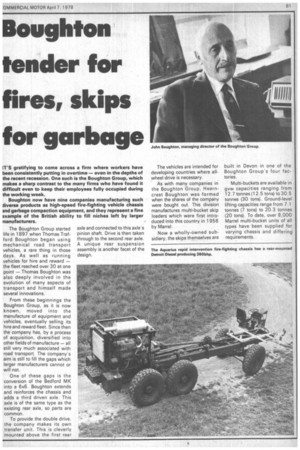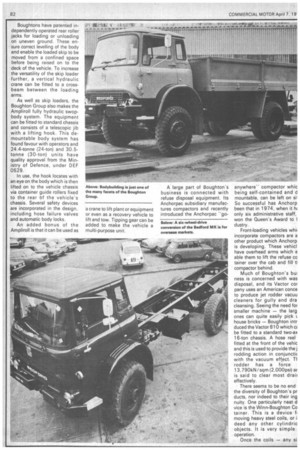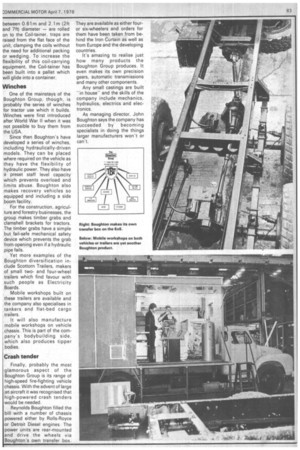Boughton tender for fires, skips for garbage
Page 87

Page 88

Page 89

If you've noticed an error in this article please click here to report it so we can fix it.
IT'S gratifying to come across a firm where workers have been consistently putting in overtime — even in the depths of the recent recession. One such is the Boughton Group, which makes a sharp contrast to the many firms who have found it difficult even to keep their employees fully occupied during the working week.
Boughton now have nine companies manufacturing such diverse products as high-speed fire-fighting vehicle chassis and garbage compaction equipment, and they represent a fine example of the British ability to fill niches left by larger manufacturers.
The Boughton Group started life in 1897 when Thomas Trafford Boughton began using mechanical road transport vehicles, a rare thing in those days. As well as running vehicles for hire and reward — the fleet reached over 30 at one point — Thomas Boughton was also deeply involved in the evolution of many aspects of transport and himself made several innovations.'
From these beginnings the Boughton Group, as it is now known, moved into the manufacture of equipment and vehicles, eventually selling its hire and reward fleet. Since then the company has, by a process of acquisition, diversified into other fields of manufacture — all still very much associated with road transport. The company's aim is still to fill the gaps which larger manufacturers cannot orwill not.
One of these gaps is the conversion of the Bedford MK into a 6x6. Boughton extends and reinforces the chassis and adds a third driven axle. This axle is of the same type as the existing rear axle, so parts are common.
To provide the double drive, the company makes its own transfer unit. This is cleverly mounted above the first rear axle and connected to this axle's pinion shaft. Drive is then taken through to the second rear axle. A unique rear suspension assembly is another facet of the design. The vehicles are intended for developing countries where allwheel drive is necessary.
As with many companies in the Boughton Group, Hearncrest Boughton was formed when the shares of the company were bought out This division manufactures multi-bucket skip loaders which were first introduced into this country in 1 956 by Marrel.
Now a wholly-owned subsidiary, the skips themselves are built in Devon in one of the Boughton Group's four factories.
Multi-buckets are available in gvw capacities ranging from 12,7 tonnes (12.5 tons) to 30.5 tonnes (30 tons). Ground-level lifting capacities range from 7.1 tonnes (7 tons) to 20.3 tonnes (20 tons). To date, over 8,000 Marrel multi-bucket units of all types have been supplied for varying chassis and differing requirements. Boughtons have patented independently operated rear roller jacks for loading or unloading on uneven ground. These ensure correct levelling of the body and enable the loaded skip to be moved from a confined space before being raised on to the deck of the vehicle. To increase the versatility of the skip loader further, a vertical hydraulic crane can be fitted to a crossbeam between the loading arms.
As well as skip loaders, the Boughton Group also makes the Ampliroll fully hydraulic swopbody system. The equipment can be fitted to standard chassis and consists of a telescopic jib with a lifting hook. This demountable body system has found favour with operators and 24.4-tonne (24-ton) and 30.5tonne (30-ton) units have quality approval from the Ministry of Defence, under DEF 0529.
In use, the hook locates with an eye on the body which is then lifted on to the vehicle chassis via container guide rollers fixed to the rear of the vehicle's chassis. Several safety devices are incorporated in the design, including hose failure valves and automatic body locks.
An added bonus of the Ampliroll is that it can be used as a crane to lift plant or equipment or even as a recovery vehicle to lift and tow. Tipping gear can be added to make the vehicle a multi-purpose unit.
A large part of Boughton's business is connected with refuse disposal equipment. Its Anchorpac subsidiary manufactures compactors and recently introduced the Arichorpac -go anywherecompactor whic being self-contained and d mountable, can be left on
So successful has Anchorp been that in 1974, when it hi only six administrative staff, won the Queen's Award to I dust ry.
Front-loading vehicles whil incorporate compactors are a other product which Anchorp. is developing. These vehicl have overhead arms which e able them to lift the refuse co tamer over the cab and fill ti compactor behind.
Much of Boughton's bu: ness is concerned with was disposal, and its Vactor cor pany uses an American conce to produce jet rodder vacuu cleaners for gully and dra cleansing. Seeing the need for smaller machine — the larg ones can quite easily pick t house bricks — Boughton intr duced the Vactor 810 which cc be fitted to a standard two-ax 16-ton chassis. A hose reel fitted at the front of the vehic and this is used to provide the j rodding action in conjunctic with the vacuum effect. 11 redder has a force 13,790kN/sqm (2,000 psi) ar is said to clear most drair effectively.
There seems to be no end the diversity of Boughton's pr ducts, nor indeed to their ing nuity. One particularly neat d vice is the Winn-Boughton Co tamer. This is a device fl moving heavy steel coils, or i deed any other cylindric objects. It is very simple operation.
Once the coils — any si between 0.61m and 2.1m (2ft and 7ft} diameter — are rolled on to the Coil-tainer, traps are raised from the flat face of the unit, clamping the coils without the need for additional packing or wedging. To increase the flexibility of this coil-carrying equipment, the Coil-tainer has been built into a pallet which will glide into a container.
Winches
One of the mainstays of the Boughton Group, though, is probably the series of winches for tractor use which it builds. Winches were first introduced after World War 11 when it was not possible to buy them from the USA.
Since then Boughton's have developed a series of winches, including hydraulically-driven models. They can be placed where required on the vehicle as they have the flexibility of hydraulic power. They also have a preset staff level capacity which prevents overload and limits abuse. Boughton also makes recovery vehicles so equipped and including a side boom facility.
For the construction, agriculture and forestry businesses, the group makes timber grabs and clamshell brackets for tractors. The timber grabs have a simple but fail-safe mechanical safety device which prevents the grab from opening even if a hydraulic pipe fails.
Yet more examples of the Boughton diversification include Scottorn Trailers, makers of small twoand four-wheel trailers which find favour with such people as Electricity Boards.
Mobile workshops built on these trailers are available and the company also specialises in tankers and flat-bed cargo trailers.
It will also manufacture mobile workshops on vehicle chassis. This is part of the company's bodybuilding side, which also produces tipper bodies.
Crash tender
Finally, probably the most glamorous aspect of the Boughton Group is its range of high-speed fire-fighting vehicle chassis. With the advent of large jet aircraft it was recognised that high-powered crash tenders would be needed.
Reynolds Boughton filled the bill with a number of chassis powered either by Rolls-Royce or Detroit Diesel engines. The power units are rear-mounted and drive the wheels via Boughton's own transfer box. They are available as either fouror six-wheelers and orders for them have been taken from behind the Iron Curtain as well as from Europe and the developing countries.
It's amazing to realise just how many products the Boughton Group produces. It even makes its own precision gears, automatic transmissions and many other components.
Any small castings are built "in houseand the skills of the company include mechanics, hydraulics, electrics and electronics.
As managing director, John Boughton says the company has succeeded by becoming specialists in doing the things larger manufacturers won't or can't.








































































































































